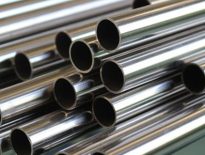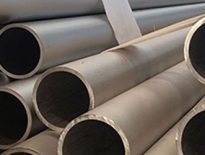What is Stainless Steel Pipe?
The construction of a pipe is round, which means the cross-section of the component is round and hollow in the center. These components are used in a piping system to distribute fluids including pellets, dust, gases, and fluids, or even steam. One of the very important distinguishing characteristics of pipes is their size. These dimensions include inside diameter or ID, outside diameter or OD, and wall thickness or WT. The wall thickness is also called the pipe schedule. Dimensions of a pipe help to the liquid capacity of the Stainless Steel Pipes. This can be determined by calculating the outside diameter minus 2 times the WT or the wall thickness (or program).
What is Stainless Steel Tube?
While a tube configuration is always round, the manufacture of tubes is possible in a variety of shapes, including round, rectangular, square, or oval. Similar to tubes, these components have dimensions such as outside diameter and weight, making them easier to order. The hollow section of pipe components is estimated from outside diameter or outside diameter, in combination with wall thickness or WT. The only difference between Stainless Steel Tubes and pipe is that for pipes, these dimensions are in inches or millimeters. The dimensions of the pipe often indicate the precise dimensional value of its hollow section.
Types of Stainless Steel Pipes
- Seamless Stainless Steel Pipes: Seamless stainless steel pipes are made without any welded joints.
- Welded Stainless Steel Pipes: Welded stainless steel pipes are manufactured by rolling stainless steel into a tube shape and welding the edges together.
- Round Stainless Steel Pipes: Round stainless steel pipes are the most commonly used type of pipe due to their versatility.
- Square and Rectangular Stainless Steel Pipes: Square and rectangular stainless steel pipes are used for specific structural and aesthetic applications.
- ERW (Electric Resistance Welded) Pipes: ERW pipes are a type of welded pipe where the edges are fused using electric resistance instead of traditional welding.
Types of Stainless Steel Tubes
- Seamless Stainless Steel Tubes: Seamless stainless steel tubes are made from a solid stainless steel billet that is heated and drawn into a tube without any joints.
- Welded Stainless Steel Tubes: Welded stainless steel tubes are produced by welding together the edges of stainless steel strips.
- Precision Stainless Steel Tubes: Precision stainless steel tubes are manufactured to tight tolerances, ensuring they meet specific size and shape requirements.
- Heat Exchanger Stainless Steel Tubes: Heat exchanger stainless steel tubes are designed to facilitate the transfer of heat between fluids in heat exchangers.
- Capillary Tubes: Capillary tubes are very small-diameter tubes used in delicate applications where precise fluid control is required. They are manufactured with extreme precision and are commonly found in the medical and scientific industries.
Key Differences Between Stainless Steel Pipe and Tube
| Feature | Stainless Steel Pipe | Stainless Steel Tube |
|---|---|---|
| Shape | Mostly round | Can be round, square, or rectangular |
| Measurement | Nominal Pipe Size (NPS) & Schedule | Outer Diameter (OD) & Wall Thickness |
| Applications | Fluid and gas transport | Structural, mechanical, and precision uses |
| Strength | Generally thicker walls for pressure resistance | Higher dimensional accuracy for precision applications |
| Fabrication | Easier to weld and thread | More precise machining required |
| Cost | Often lower per unit length | More expensive due to precision requirements |
| Surface Finish | Rougher surface | Available in polished, seamless finishes |
Difference Between Pipe and Tube Diameter
During placement of the order, it is possible to order, you can order a pipe with dimensions such as outside diameter and wall thickness. In addition, in a few instances, the order can also be positioned with dimensions like OD & ID and Wall Thickness. Generally, the ID or the internal diameter is theoretical, however, the wall thickness of a given tube has been described with the aid of using a gauge quantity. Smaller gauge numbers are related to having large outdoor diameters. On the alternative hand, the tube is ordered with the NPS standard, additionally, this system quantity and the amplifier; nominal diameter or pipe length need to be specified.
Pipe and Tube Production Process
Similar to pipes, tubes may be produced with both seamless or welded construction. In addition, it is very difficult to manufacture a tube because the tolerances of the tubes are tighter. The manufacturer must therefore comply with all of them to meet the tolerances established by the standards or specifications. And because the manufacturing process of tubes entails a finished product, several parameters need to be reviewed, including test procedures, quality controls, and inspections.
Applications of Stainless Steel Pipes and Tubes
Stainless steel pipes and tubes are widely utilized across various industries due to their durability, strength, and corrosion resistance. Their ability to withstand extreme conditions, including high temperatures and pressure, makes them ideal for diverse applications. Below are some key sectors where stainless steel pipes and tubes play a significant role.
- Construction and Infrastructure : Stainless steel pipes and tubes are extensively used in the construction industry for their structural strength and aesthetic appeal. They are commonly found in building frameworks and support structures, handrails, staircases, modern architecture, Water supply and drainage systems.
- Oil and Gas Industry : The oil and gas sector demands high-strength materials capable of withstanding extreme temperatures, pressure, and corrosive environments. Stainless steel pipes and tubes are used for transportation of crude oil, natural gas, and refined petroleum, Offshore drilling rigs and subsea pipelines, processing plants and refinery structures.
- Plumbing and Water Treatment : Stainless steel pipes are widely used in plumbing and water treatment facilities due to their durability and hygienic properties. They are used for Municipal and residential water distribution systems, Wastewater treatment and desalination plants, Industrial plumbing systems and agricultural water supply.
- Automotive and Transportation : The automotive and transportation industries rely on stainless steel pipes and tubes for their high strength, lightweight nature, and resistance to extreme conditions. Applications include, Exhaust systems and catalytic converters, Hydraulic and fuel lines, Railway and aerospace engineering.
- Food and Beverage Industry : Stainless steel is a preferred material in the food and beverage sector due to its non-reactive nature and easy-to-clean surface. Common applications are processing and storage of dairy, meat, and beverages.
- Chemical and Pharmaceutical Industries : Stainless steel pipes and tubes are widely used in chemical and pharmaceutical industries where resistance to corrosion and chemical reactions is crucial.
- Heat Exchangers and Power Generation : The energy sector relies on stainless steel tubes for heat exchange and power generation. These tubes are commonly used in thermal and nuclear power plants, Boilers and steam generators, Solar energy and geothermal plants, refrigeration and air conditioning units.
- Medical and Healthcare Sector : In the medical field, stainless steel is essential for maintaining hygiene, safety, and durability.
Stainless Steel Grades in Pipes and Tubes
Different grades of stainless steel are used to make stainless steel pipes and tubes and each grade has unique properties that make it suitable for a range of uses. With varying degrees of strength, heat resistance, and corrosion resistance, 304, 316, and 310 are the most often used grades. You can choose the ideal material for your project by being aware of the grades and their characteristics.
304 Stainless Steel: 304 stainless steel is the most often used grade and is perfect for a variety of applications.
316 Stainless Steel: Particularly in chloride-rich conditions, such those found in the chemical and marine sectors, 316 stainless steel is renowned for its exceptional resistance to corrosion.
310 Stainless Steel: It is perfect for high-temperature applications due to its high heat resistance.
Conclusion
Understanding the difference between stainless steel pipes and tubes is crucial for selecting the right material for any given project. While both offer exceptional durability, corrosion resistance, and strength, they serve distinct purposes. Pipes are generally used for the transportation of fluids and gases, with dimensions focused on internal flow capacity, while tubes are more versatile in shape and are often used for structural, mechanical, or precision applications. Choosing between a pipe and a tube depends on the specific requirements of size, shape, strength, and functionality for the task at hand. With various types of both pipes and tubes available, it’s essential to match the right one to the job to ensure long-lasting performance and reliability.
For your next project, trust Solitaire Overseas to provide high-quality stainless steel pipes and tubes that meet your exact specifications. Contact us today to learn more about our products and how we can help you achieve optimal results.
FAQs
Is stainless steel good for pipes?
Stainless steel is excellent for pipes. It offers durability, easy maintenance, and simple installation. Its corrosion-resistant properties ensure longevity, making it a reliable material that can last for decades without needing replacement.
What are the disadvantages of stainless steel pipes?
Heavy Weight: Stainless steel pipes are heavier than other types, making transportation and installation more challenging.Difficulty Welding: Due to their heat resistance, stainless steel pipes are hard to weld. Improper welding can lead to leaks at the joints.
What are stainless steel tubes?
Stainless steel tubes are long, cylindrical products used to transport fluids and gas or for structural applications. Made from stainless steel, these tubes offer strong corrosion resistance and are suitable for high-temperature, corrosive, or high-contaminant environments.
What is the difference between stainless steel pipe and tube?
The primary difference is shape and purpose. Pipes are always round and designed for transporting fluids and gas. Tubes can be round, square, rectangular, or oval, and are used for structural applications, precision, or aesthetic purposes.
Can stainless steel pipes be used in high-temperature applications?
Yes, some grades of stainless steel are specifically designed for high-temperature service. Grades like 304, 310, and 316 are commonly used in high-temperature environments.
What is the difference between welded and seamless stainless steel pipes?
Seamless Stainless Steel Pipes are made by extruding solid stainless steel billets and then drawing them into pipes without welding. The process results in a uniform pipe with no weld seam.
Welded Stainless Steel Pipes are made by rolling a flat sheet of stainless steel into a cylindrical shape and welding the edges together. This process is known as electric resistance welding (ERW) or other welding techniques.


